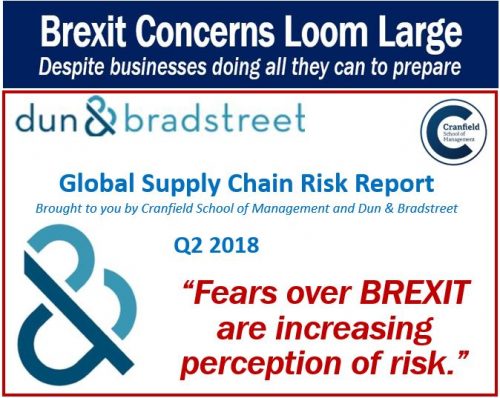Even though businesses have taken many steps to ready themselves, Brexit fears are increasing. Brexit fears regarding companies’ perception of supply chain risks, especially, are growing, says a new report.
BREXIT stands for BRitain EXITing the European Union.
Dun & Bradstreet and the Cranfield School of Management have published the Q2 2018 Global Supply Chain Risk Report. The authors investigated the levels of perceived and actual supply chain risk that European companies face with international supplier relationships.
Dr. Heather Skipworth and fellow authors found that businesses in many sectors seem to be taking measures to reduce supply chain risk.
However, in spite of this, many still feel that they are in jeopardy. They fear they are vulnerable because they are heavily reliant on key or critical suppliers.
Dr. Skipworth is a Senior Lecturer in Logistics, Procurement, and Supply Chain Management at Cranfield.
Logistics focuses on the challenge of planning and coordinating the flow of materials and information. It is a subset of supply chain management.
Procurement is the process of finding and acquiring goods, services, or works from an external source. Procurement also includes agreeing terms.

Supply chain risk – supplier criticality
Overall, the authors found that supplier criticality had risen by two percent in the second quarter of 2018. Over the past three quarters, supplier criticality rose by twelve percent.
Supplier criticality refers to the percentage of unique purchaser-supplier relationships where the purchaser categorizes the supplier as key or critical. When the number is large, it suggests a greater perceived exposure to risks from the supply base.
Regarding supplier criticality, Dr. Skipworth said:
“Supplier criticality is the only risk metric used in the report that relies on perception rather than ‘hard’ numbers, and it is interesting to see the different story it shows.”
“It looks like the continuing uncertainty surrounding Brexit is feeding buying companies’ perceptions of an increasing level of dependency on their suppliers, despite the fact that the other metrics suggest several sectors are taking significant action to reduce their supply chain risk.”
“As the March 2019 deadline approaches, it appears the uncertainty around the tariffs, barriers and trade agreements that will impact supply chain relationships is more and more in the forefront of businesses’ minds.”
Assessing overall supply chain risk
The Global Supply Chain Risk Report uses four different metrics: foreign exchange risk, global sourcing risk, supplier criticality, and supplier financial risk.
It uses the four metrics to assess overall supply chain risk. It also provides companies with a view of trends across the whole economy as well as within their industry sector.
By analyzing each sector, the report highlights areas that require close monitoring and consideration. Specifically, areas for consideration and monitoring regarding procurement decisions.
The authors gathered and analyzed Dun & Bradstreet’s propriety commercial data. The data includes approximately 500,000 anonymous transactions between suppliers and their European buyers. The suppliers are located in over 150 countries across the world.
Breakdown by sectors Q2 2018
Infrastructure
In this article, the ‘infrastructure sector’ comprises communications, transportation, gas, electric, and sanitary services.
The infrastructure sector reduced:
– supplier financial risk by 3%,
– foreign exchange risk by 22%, and
– global sourcing risk by 21.3%.
Construction
Global sourcing risk rose by 1.1%. Foreign exchange risk and supplier financial risk, on the other hand, remained nearly the same.
However, in spite of this, purchasing companies’ dependence on suppliers rose by 2.4%.
Manufacturing
– Global sourcing risk rose by 1.4%.
– Foreign exchange risk increased by 1.6%. The rate of risk of global sourcing and foreign exchange, however, slowed significantly.
– Supplier financial risk remained the same at 23.3%. Perhaps this was the result of concerted action to mitigate against perceived risks.
Retail
The authors also highlighted potential causes for concern in the retail sector. Retail has the highest financial risk, which stood at 24.1% in Q2 2018. This was two percent higher than in Q1 2018 and 7% over the previous three quarters.
Wide risk metrics, however, remained the same. This suggests that the risk of insolvency in the supplier base has increased.
Regarding supply chain risk across different sectors, Chris Laws said:
“The data continues to show a variance in supply chain risk across different industry sectors.”
“With an increasingly complex and uncertain environment, businesses that analyze and monitor their supply chain closely can take steps to identify and help mitigate risk to protect their business and plan ahead.”
Laws is Head of Product Development – Supply & Compliance at Dun & Bradstreet.
